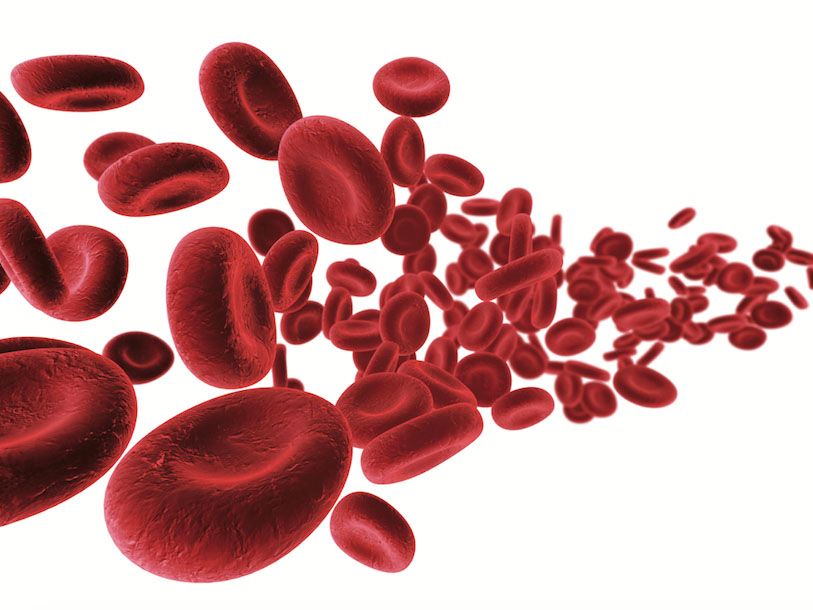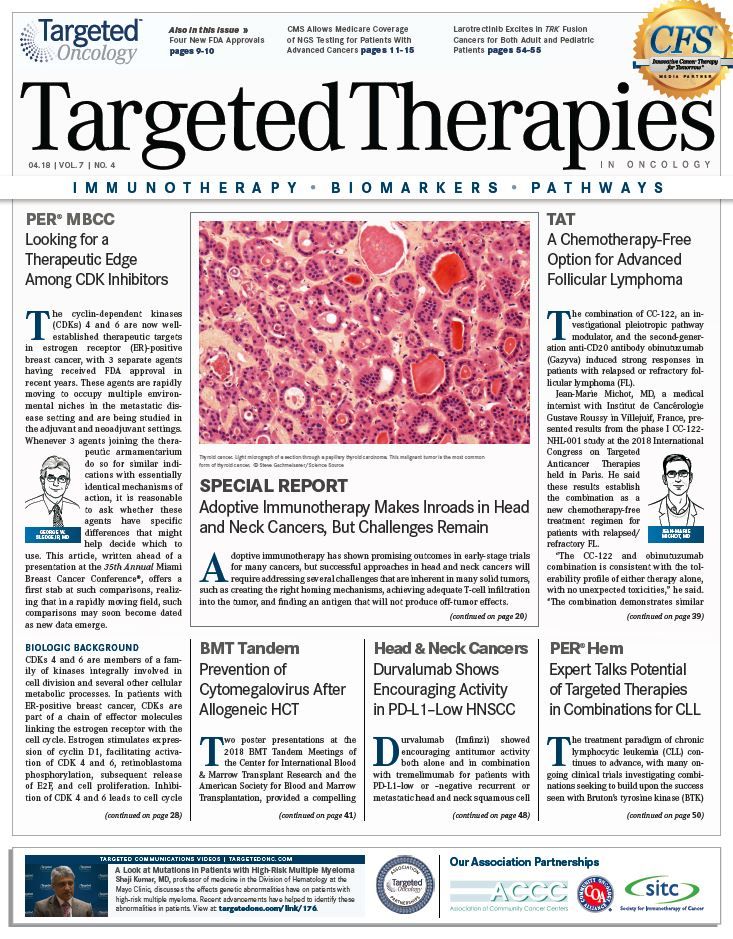Prevention of Cytomegalovirus After Allogeneic HSCT
Two poster presentations at the 2018 BMT Tandem Meetings of the Center for International Blood & Marrow Transplant Research and the American Society for Blood and Marrow Transplantation, provided a compelling extension of the recent phase III clinical trial that demonstrated the efficacy of prophylactic therapy with letermovir (Prevymis) for the prevention of cytomeg alovirus (CMV) infection in patients receiving allogeneic hematopoietic stem cell transplantation (HSCT).

Two poster presentations at the 2018 BMT Tandem Meetings of the Center for International Blood & Marrow Transplant Research and the American Society for Blood and Marrow Transplantation, provided a compelling extension of the recent phase III clinical trial that demonstrated the efficacy of prophylactic therapy with letermovir (Prevymis) for the prevention of cytomeg alovirus (CMV) infection in patients receiving allogeneic hematopoietic stem cell transplantation (HSCT).1,2
Immunosuppression is necessary for the success of HSCT, but it carries the danger of lessened resistance to potentially lethal infections like CMV, which is among the most common infections that occur following transplantation. The normal post-HSCT strategy for over a decade has involved blood checks for the presence of CMV nucleic acid in patients who display no symptoms of infection. If the genetic material is detected, treatment swings to a reactive response involving intravenous (IV) ganciclovir (Zirgan) or its oral prolog, valganciclovir (Valcyte), or the IV application of either foscarnet (Foscavir) or cidofovir (Vistide).
The reactive approach works, but its adverse events (AEs), including myelosuppression and renal toxicity, mean that therapy is short term. Enter letermovir, a first-in-class inhibitor of the terminase complex of CMV, and the idea of its preemptive use “from the get-go” in patients scheduled for allogeneic HSCT (allo-HSCT), explained Roy F. Chemaly, MD, MPH, a professor in the Department of Infectious Diseases, Infection Control and Employee Health at The University of Texas MD Anderson Cancer Center, during an interview with Targeted Therapies in Oncology™. Chemaly was an author on the phase III letermovir prophylaxis study published in the New England Journal of Medicine.3
The phase III study randomized 565 patients to oral or IV treatment with letermovir (480 mg/day or half that dose in patients receiving concomitant cyclosporine; n = 376) or placebo (n = 194) for 14 weeks following HSCT, with follow-up to week 48. Treatment began at a median of 9 days post HSCT.
The rates of all-cause mortality at week 24 were 10.6% (95% CI, 7.4%-13.9%) and 15.5% (95% CI, 10.1%- 20.9%) in the letermovir and placebo arms, respectively (P = .0560). The treatment-related, nonsignificant, survival advantage was maintained through week 48.
At week 24, clinically significant CMV infection had developed in 37.5% of patients in the letermovir arm and in 60.6% of those in the placebo arm (P <.0001). The risk of all-cause death at 48 weeks in these patients was lower in the letermovir arm (17.7%) than in the placebo arm (29.5%).
Following the release of the study’s results, clinicians led by Chemaly retrospectively examined data from an 18-hospital database of patients undergoing HSCT to assess the clinical outcome and the economic burden of CMV reactivation.1Between 2012 and 2015, 100 consecutive patients hospitalized at MD Anderson for allo-HSCT who experienced reactivation of CMV were enrolled. The scenario for these patients was the current status quo of care, which treats CMV preemptively.
Just over half the patients were male, and the majority (73%) had underlying leukemia. Fifty-nine patients underwent matched unrelated donor transplantation. At the time of their hospitalization, 62 patients had acute graft-versus-host disease. Steroid therapy was initiated within a month of CMV reactivation in 58 patients. Time until CMV reactivation varied widely, from 2 to 174 days following allo-HSCT, with a median of 32 days.
Within the first year following HSCT, preemptive therapy was done 192 times. Medications included ganciclovir, foscarnet, or valganciclovir, with IV immunoglobulin used as an adjuvant therapy 20 times. Progression to CMV disease occurred in 4 of the 100 patients. The mean hospitalization time was similar for patients treated with ganciclovir and foscarnet.
To get a better handle on inpatient costs, the investigators analyzed the data from MD Anderson and 17 other hospitals using the Vizient database. The composite data revealed that the retroactive response added to the cost of treatment, particularly when there were serious AEs from the foscarnet therapy (the total direct cost per encounter in these patients was $284,006 versus $112,195 for patients without serious AEs).
The findings “underscore the significant impact of CMV reactivation and preemptive therapy in terms of economic and clinical burden in allo-HSCT patients,” said Chemaly.
Whether the prophylactic letermovir strategy actually decreases the real-world burden of CMV beyond the recent clinical trial remains to be determined and is the subject of ongoing analyses. For now, though, the study makes clear the clinical and economic toll of CMV in the allo-HSCT setting.
The study presented in the second poster homed in on the use of letermovir, using a decision-analytic model to evaluate the cost-effectiveness of the letermovir prophylaxis compared with the standard preemptive treatment.2The total cost of patient treatment and the longer-term burden of CMV on the quality and length of life was measured by the parameters of life-years gained and quality-adjusted life-years. The model was deliberately designed to be simple, and it relied on data obtained from the published phase III trial findings, boosting confidence in the real-life ramifications of the model predictions.
“The model is able to use clinical inputs and measures of health care resource utilization from a randomized, placebo-controlled clinical trial. These data are generally considered the gold standard for model inputs,” explained Jonathan Schelfhout, PhD, director of outcomes research at Merck & Co, Inc, in an interview. Schelfhout was involved in both posters and in the phase III trial of letermovir prophylaxis.
The analysis involved 1000 patients who were followed until death. The actual patient data showed that the prophylactic use of letermovir reduced the number of CMV infections that required subsequent preemptive treatment (189 vs 443) 24 weeks after allo-HSCT. “Prophylaxis with letermovir resulted in fewer cases of mortality and an increase in life-years and quality-adjusted life-years,” said Schelfhout.
The prophylaxis strategy did increase the cost of treatment; however, the longer-term benefits more than outweighed this expense. “The results of this model suggest that letermovir is an excellent value, with a cost per quality-adjusted life-year of $25,222. The number is well beneath the thresholds of $100,000 or $150,000 that are typically cited for evaluating whether an intervention is cost-effective in the United States. These results were robust to changes in the inputs of the model, as a probabilistic sensitivity analysis indicated that letermovir was cost-effective in 93.5% of iterations at $100,000 per quality-adjusted life-year gained and 95.2% of iterations at $150,000 per quality-adjusted life-year gained,” said Schelfhout.
The relative lack of published cost data for CMV and the model’s lack of inclusion of costs other than direct treatment costs are acknowledged limitations of the approach. Further research will flesh out these aspects and, it is anticipated, continue to strengthen the case for letermovir prophylaxis.
References:
- Ghantoji SS, Schelfhout J, El Haddad L, et al. Clinical & economic burden of pre-emptive therapy (PET) of cytomegalovirus (CMV) infection in hospitalized allogeneic hematopoietic cell transplant (allo-HCT) recipients: the MD Anderson Cancer Center experience. Presented at: 2018 BMT Tandem Meetings; February 21-25, 2018; Salt Lake City, UT. Abstract 542. bmt.confex.com/tandem/2018/meetingapp. cgi/Paper/10782.
- Schelfhout J, Jiang Y, Miles L, et al. Cost effectiveness of letermovir as cytomegalovirus prophylaxis in in allogeneic hematopoietic stem cell transplant recipients. Presented at: 2018 BMT Tandem Meetings; February 21-25, 2018; Salt Lake City, UT. Abstract 557. bmt.confex.com/tandem/2018/meetingapp.cgi/Paper/11263.
- Marty FM, Ljungman P, Chemaly RF, et al. Letermovir prophylaxis for cytomegalovirus in hematopoietic-cell transplantation. N Engl J Med. 2017;377(25):2433-2444. doi: 10.1056/NEJMoa1706640.

Survivorship Care Promotes Evidence-Based Approaches for Quality of Life and Beyond
March 21st 2025Frank J. Penedo, PhD, explains the challenges of survivorship care for patients with cancer and how he implements programs to support patients’ emotional, physical, and practical needs.
Read More